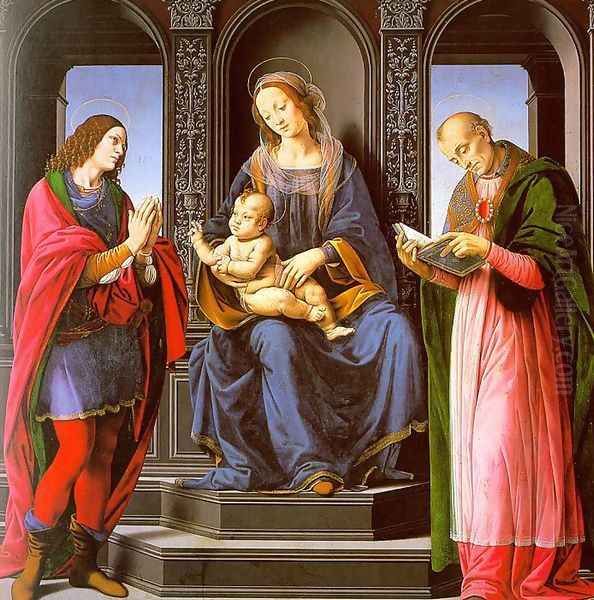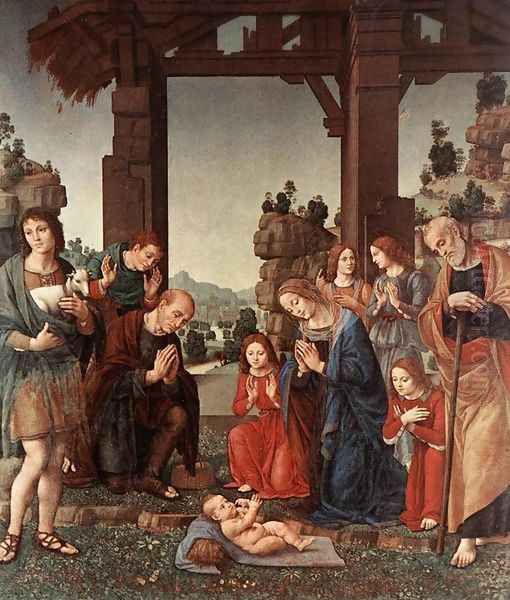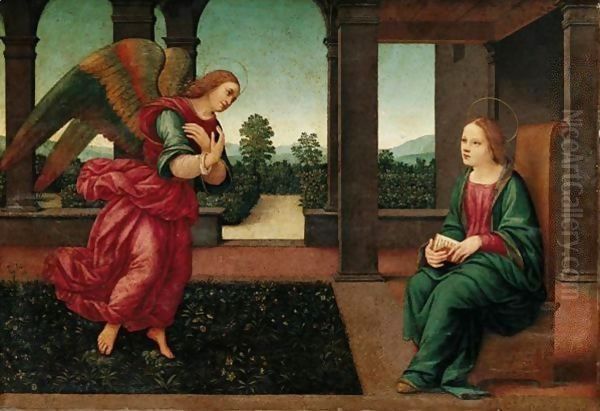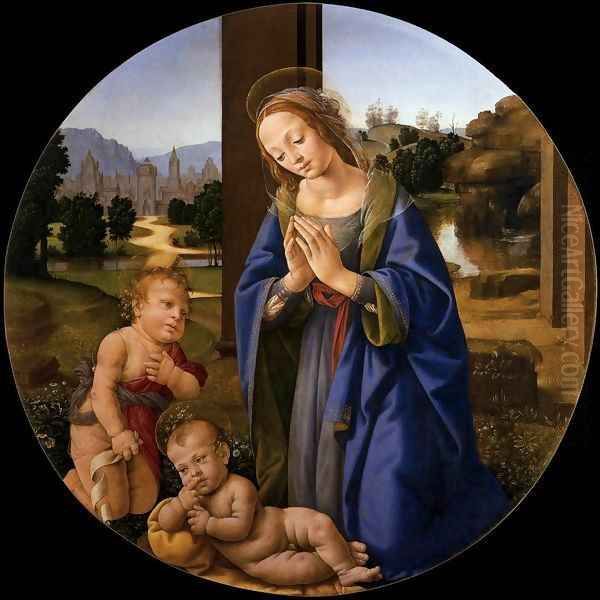Lorenzo di Credi stands as a significant, if sometimes overshadowed, figure in the constellation of artists who defined the Florentine Renaissance. A painter and sculptor of considerable skill, his life and career were intertwined with some of the era's most luminous names, most notably Leonardo da Vinci and his master Andrea del Verrocchio. While perhaps not possessing the revolutionary genius of Leonardo or the dramatic power of Michelangelo, Credi carved out a respected niche for himself through his meticulous technique, refined sensibility, and dedication to his craft. His oeuvre, primarily consisting of religious subjects, particularly Madonnas and altarpieces, reflects the prevailing artistic currents of late Quattrocento and early Cinquecento Florence, showcasing a deep understanding of composition, color, and the subtle rendering of human form and emotion.
Early Life and Formative Years in Verrocchio's Crucible
Born Lorenzo d'Andrea d'Oderigo Barducci in Florence around 1459 or 1460, the artist later became known as Lorenzo di Credi, likely after his mother, Lisa di Credi, or perhaps adopting the name of a goldsmith master with whom his father, Andrea d'Oderigo, a goldsmith himself, may have been associated. The exact etymology of "di Credi" remains a point of minor scholarly discussion, but it is the name by which he achieved contemporary and posthumous recognition. His initial artistic training undoubtedly began in his father's goldsmith workshop. This early exposure to the precise and detailed work of a goldsmith would have instilled in him a discipline and an appreciation for fine craftsmanship that remained evident throughout his painting career.
The pivotal moment in Lorenzo di Credi's artistic development came when he entered the bustling workshop of Andrea del Verrocchio. Verrocchio's bottega was one of the most important and versatile artistic enterprises in Florence, a veritable crucible of talent that produced not only painters but also sculptors, goldsmiths, and decorative artists. It was here that Credi's path converged with that of Leonardo da Vinci, who was a senior apprentice or collaborator when Credi likely joined, and Pietro Perugino, another future master who passed through Verrocchio's tutelage. The environment was one of intense learning, collaboration, and friendly rivalry.

Andrea del Verrocchio (c. 1435–1488) was a master of multiple media. His sculptures, such as the bronze David (Bargello, Florence) and the powerful equestrian statue of Bartolomeo Colleoni in Venice (completed after his death), demonstrate his profound understanding of anatomy and dynamic form. In painting, works like The Baptism of Christ (Uffizi, Florence), famously featuring an angel painted by the young Leonardo, showcase the workshop's high standards. Lorenzo di Credi absorbed Verrocchio's emphasis on precise drawing, careful modeling of forms, and the use of oil glazes to achieve luminous color and subtle gradations of tone. He became one of Verrocchio's most trusted assistants and, eventually, his principal heir in the workshop.
Artistic Style: Precision, Grace, and the Shadow of Giants
Lorenzo di Credi's artistic style is characterized by its meticulous finish, delicate modeling, and serene, often sweet, expressions in his figures. His paintings are typically well-balanced, with clear compositions and a harmonious use of color. He excelled in rendering textures, from the softness of drapery to the sheen of metal, a skill likely honed during his early goldsmith training. His landscapes, often forming the backgrounds of his religious scenes, are rendered with care, though they tend to be somewhat conventional rather than imbued with the atmospheric depth seen in Leonardo's work.
The influence of Andrea del Verrocchio is palpable in Credi's early works, particularly in the somewhat sculptural quality of his figures and the clarity of his outlines. However, the pervasive influence of Leonardo da Vinci (1452–1519) is arguably even more significant and complex. Working alongside Leonardo, Credi would have witnessed firsthand the older artist's revolutionary approach to light and shadow (chiaroscuro), his use of sfumato (the subtle blending of tones to create soft, hazy outlines), and his profound psychological insight into his subjects.
Credi adopted elements of Leonardo's technique, particularly the soft modeling and the delicate rendering of features. Some of his Madonnas, with their gentle smiles and tender interactions with the Christ Child, clearly echo Leonardesque prototypes. However, Credi's interpretation of these elements often resulted in a style that, while technically proficient and aesthetically pleasing, sometimes lacked the intellectual depth, innovative spirit, and sheer vitality of Leonardo's art. Art historian Giorgio Vasari, in his Lives of the Most Excellent Painters, Sculptors, and Architects (1550, revised 1568), praised Credi for his diligence and the "extreme finish" of his works but also noted that he was "somewhat hard and crude" in his early period and that his painstaking methods could lead to a certain stiffness. Vasari remarked that Credi was so meticulous that he would grind his own colors and distill his own oils, ensuring an almost obsessive level of control over his materials.

While Leonardo was a profound innovator, constantly experimenting and pushing artistic boundaries, Credi was more of a refiner and a perfectionist within established norms. His figures, though graceful, can sometimes appear overly polished or idealized, lacking the intense inner life or the subtle ambiguities that make Leonardo's figures so compelling. This has led some critics to view Credi as a talented but ultimately conservative artist, a skillful synthesizer rather than a groundbreaking pioneer.
Other contemporaries also left their mark. The influence of Pietro Perugino (c. 1446/1452–1523), known for his sweet-faced Madonnas and serene compositions, can be discerned in the gentle piety of some of Credi's figures. Later in his career, Credi seems to have responded to the developing High Renaissance style, particularly the work of Fra Bartolomeo (1472–1517), whose monumental figures and rich, harmonious color schemes became influential in Florence. There's a sense that Credi was always receptive to the artistic currents around him, adapting and incorporating elements that resonated with his own meticulous temperament.
Key Works and Commissions
Lorenzo di Credi's oeuvre is substantial, with many of his most important works still housed in Florentine collections, a testament to his local reputation.
One of his most significant early commissions, inherited from Verrocchio, was the altarpiece of the Madonna and Child with St. John the Baptist and St. Donatus (also known as the Madonna di Piazza) for the Pistoia Cathedral, completed around 1485-1490. This work, on which Leonardo is also thought to have contributed to the predella panel of the Annunciation (now in the Louvre), showcases Credi's ability to manage a large-scale composition and demonstrates his developing style, still closely aligned with Verrocchio's but with emerging Leonardesque softness.
The Uffizi Gallery in Florence holds several key works by Credi. His Annunciation (c. 1480-1485) is a beautifully crafted panel, displaying his characteristic clarity, delicate color palette, and attention to detail in the architectural setting and landscape. The figures of the Virgin and the Archangel Gabriel are graceful and serene. Another important Uffizi piece is the Adoration of the Shepherds (c. 1510), a later work that shows a richer, more High Renaissance sensibility in its coloration and the fuller forms of the figures, possibly reflecting the influence of artists like Fra Bartolomeo. His Venus (c. 1493-1495, Uffizi), a rare mythological subject for him, is notable for its chaste and somewhat sculptural depiction of the goddess, differing significantly from the more sensual interpretations by artists like Sandro Botticelli (c. 1445–1510).

The Madonna and Child with the Young St. John the Baptist was a theme Credi returned to frequently, producing numerous variations, many of which are now in collections worldwide. These tondi (circular paintings) and rectangular panels often feature tender interactions between the figures, set against meticulously rendered landscapes. Examples include the Madonna and Child at the Galleria Borghese in Rome and another version at the Alte Pinakothek in Munich. These works were highly sought after for private devotion.
A particularly debated work is the Annunciation now in the Musée du Louvre, Paris. While traditionally attributed to Leonardo da Vinci as an early work, or a collaborative piece from Verrocchio's workshop, some scholars have argued strongly for Lorenzo di Credi's authorship, or at least a very significant contribution. The meticulous finish and certain stylistic traits are indeed reminiscent of Credi, highlighting the complex interplay of hands and styles within Verrocchio's studio and the challenge of definitive attribution for workshop productions.
Another notable altarpiece is The Virgin and Child with St. Julian and St. Nicholas of Myra (c. 1490-1494), also in the Louvre. This work is a fine example of a sacra conversazione (sacred conversation), with the Virgin and Child enthroned centrally, flanked by saints. The composition is balanced and harmonious, the figures rendered with Credi's typical refinement and gentle piety. The detailed depiction of the saints' attributes and the rich textures of their vestments are characteristic of his style.
His portraiture, though less extensive than his religious output, also deserves mention. The Portrait of a Young Woman (or Portrait of Caterina Sforza) at the Pinacoteca Civica in Forlì is a striking example, showcasing his ability to capture a likeness with precision and a certain reserved dignity. The sitter's features are delicately modeled, and the costume is rendered with his customary attention to detail.
The Workshop, Later Career, and Reputation
Upon Andrea del Verrocchio's death in Venice in 1488, Lorenzo di Credi, as his designated heir, was entrusted with the responsibility of completing his master's unfinished commissions, most notably the casting and finishing of the Colleoni equestrian monument. This was a significant undertaking and a mark of the trust Verrocchio placed in him. Credi managed Verrocchio's workshop in Florence for a period, continuing its tradition of producing high-quality paintings and, to a lesser extent, sculpture.

However, while he inherited the workshop, Credi did not seem to attract the same scale or prestige of commissions that Verrocchio had enjoyed, nor did his workshop become a similar powerhouse of innovation. This might be attributed to several factors: the changing artistic landscape of Florence with the rise of new talents, Credi's own somewhat conservative artistic temperament, and perhaps a preference for more manageable, finely wrought devotional panels over large-scale, complex projects.
Despite this, Credi remained a respected figure in the Florentine artistic community. He was known for his probity and was often called upon to act as an arbitrator in disputes between artists or to value artworks. For instance, he was part of the committee of artists, which included luminaries like Leonardo da Vinci, Sandro Botticelli, Filippino Lippi (c. 1457–1504), Pietro Perugino, Andrea della Robbia (1435–1525), and Cosimo Rosselli (1439–1507), convened in 1504 to decide on the optimal placement for Michelangelo's (1475–1564) colossal statue of David. His inclusion in such a distinguished panel underscores his standing among his peers.
In his later years, Credi's style became somewhat more formulaic, and his output may have increasingly relied on workshop assistants. He was a devout follower of the reformist preacher Girolamo Savonarola, and it is said that, influenced by Savonarola's fiery sermons against worldly vanities, Credi destroyed some of his own paintings on secular themes during the infamous "Bonfire of the Vanities" in 1497. This religious fervor might also explain the predominantly sacred nature of his surviving oeuvre.
Artists like Domenico Ghirlandaio (1448/49–1494), another highly successful workshop head in Florence, focused on narrative frescoes and portraits that captured the Florentine society of his time. Piero di Cosimo (1462–1522), an eccentric and imaginative painter, explored mythological and allegorical themes with a unique sensibility. Compared to these varied outputs, Credi's focus remained largely on devotional paintings, executed with unwavering care. Even younger masters emerging in the High Renaissance, such as Raphael (1483–1520), who spent time in Florence and absorbed lessons from Leonardo and Fra Bartolomeo, quickly developed a more dynamic and monumental style that would define the new era.
Lorenzo di Credi never married and, according to Vasari, became somewhat reclusive in his old age. He made his will in 1531 and retired to the Hospital of Santa Maria Nuova in Florence, a common practice for elderly individuals, particularly those without close family to care for them. He died there on January 12, 1537, at the advanced age of around 78.
Legacy and Art Historical Assessment

Lorenzo di Credi's legacy is that of a highly skilled and conscientious artist who perfectly embodied certain aspects of the Florentine Renaissance tradition. His dedication to craftsmanship, his refined aesthetic, and his ability to create images of serene beauty earned him considerable respect during his lifetime. He was a master of technique, particularly in the meticulous application of paint and the creation of smooth, enamel-like surfaces.
However, in the grand narrative of art history, Credi is often seen as a secondary figure, overshadowed by the towering geniuses of Leonardo da Vinci, Michelangelo, and Raphael. His art, while beautiful and technically accomplished, is generally considered to lack the profound innovation, intellectual depth, or emotional power of these masters. His reliance on established formulas and his tendency towards a somewhat sweet, if polished, idealism meant that his work did not significantly alter the course of art history in the way that Leonardo's did.
The close association with Leonardo has been both a blessing and a curse for Credi's reputation. On one hand, it places him in esteemed company and highlights his access to cutting-edge artistic developments. On the other, it inevitably invites comparisons that often leave Credi appearing less original. The "Leonardesque" qualities in Credi's work – the soft modeling, the gentle smiles – are often seen as derivations rather than independent innovations.
Nevertheless, to dismiss Credi as merely an imitator would be unjust. He developed a recognizable personal style that, while indebted to his master Verrocchio and his colleague Leonardo, possessed its own distinct qualities of clarity, refinement, and gentle piety. His best works, such as the Pistoia altarpiece, the Uffizi Annunciation, and many of his Madonna and Child compositions, are exquisite examples of late Quattrocento Florentine painting. They reflect a sincere religious sensibility and a profound dedication to the art of painting.
His role as the heir to Verrocchio's workshop also positions him as an important transitional figure, carrying forward the traditions of one of the 15th century's most significant artistic enterprises into the early 16th century. His meticulousness, as noted by Vasari, while perhaps limiting his expressive range, also ensured the high quality and durability of his works, many of which survive in excellent condition.
In recent decades, art historians have sought a more nuanced understanding of artists like Lorenzo di Credi, moving beyond simple comparisons with the "great masters" to appreciate their individual contributions within their specific historical and artistic contexts. Credi's paintings offer valuable insights into the artistic practices, patronage, and devotional culture of Renaissance Florence. He represents a significant strand of Florentine art that valued technical perfection, harmonious composition, and serene beauty.
Conclusion: A Master of Refinement
Lorenzo di Credi was an artist of considerable talent and unwavering dedication. Nurtured in the exceptional environment of Verrocchio's workshop alongside Leonardo da Vinci, he absorbed the lessons of his master and his brilliant contemporary, forging a style characterized by meticulous finish, delicate modeling, and a gentle, pious sentiment. While his work may not have possessed the revolutionary impact of some of his peers, his contributions to the Florentine Renaissance are undeniable. His beautifully crafted altarpieces, devotional panels, and portraits were highly esteemed in his time and continue to be admired for their technical excellence and serene grace. As a custodian of Verrocchio's legacy and a respected member of the Florentine artistic community, Lorenzo di Credi holds a secure and honorable place in the rich tapestry of Italian Renaissance art, a testament to a lifetime spent in pursuit of artistic perfection. His paintings remain a quiet but compelling voice from an era of extraordinary artistic ferment.